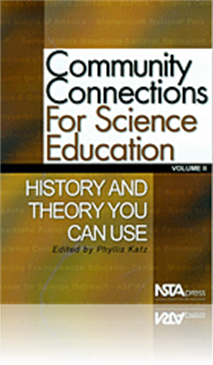All Resources
Journal Article
Active Learning in the Lab: Positively influencing student attitudes toward chemistry
One of the greatest challenges in education is finding methods of making learning meaningful for students while effectively preparing them for the workplace. One way to meet this challenge is to actively involve students in learning allowing them to ...
Journal Article
The Virtual Solar System Project
In the course, Virtual Solar System, students construct models of the solar system in an inquiry framework to learn fundamental astronomical concepts. This paper describes the course, the underlying principles for its design, the core technology that...
Journal Article
This memorable activity creatively applied students’ knowledge of ants—and it all started with a wonderful Lawrence Hall GEMS guide and a teacher with a sweet tooth. The students learned that the success of the colony depends on each ant doing it...
Journal Article
An opinion piece about teachers making mistakes and how students will learn to accept failed demonstrations and be challenged by them....
Journal Article
An opinion piece about symmetry stating that it has been increasingly recognized by physicists as fundamental to the forumlation of the laws of physics....
Journal Article
"Wow, our plastic load flew 540 centimeters! This is so cool!" An interdisciplinary unit on catapults was responsible for the excitement and enthusiasm generated in the author’s classroom. In their social studies class, students learned about the M...
Journal Article
Research and Teaching: Raising Success Rates in Freshman Chemistry
Using data collected from student records and surveys, this article examines the likelihood of student success in a spring section of freshman chemistry populated by many students deemed at risk of failure. The study also considers the relationship b...
Journal Article
Action-Based Research Teams: Collaborating to Improve Science Instruction
Action-based research teams, a partnership of scientists, science educators, master teachers, graduate students and undergraduates, have been established at Purdue University to improve undergraduate instruction in the sciences. Action-based research...
Journal Article
Meteorology Online: Weather forecasting using the Internet
Today, worldwide up-to-the-minute weather information is just a few mouse clicks away on the Internet. The trick is to apply this information in ways that make us think and learn more effectively. Meteorology embodies elements of physics, geography, ...
Journal Article
Changing the Culture of Undergraduate Science Teaching
Faculty at several Arizona institutions collaborated to change the culture of science teaching by introducing comprehensive and systemic reforms in undergraduate science and math courses. Preliminary measurements of the effectiveness of the reformed ...
Journal Article
Making a Mini-Submarine: An open-ended investigation with positively buoyant results
A minature submarine is a fascinating toy that sinks and rises in a container of water. They make excellent teaching tools for illustrating the concept of density and buoyancy. In this article, students are challenged to produce minature submarines t...
Journal Article
Students are enthusiastic with the multi-resource learning environment in which multiple resources, such as the Internet, science posters, magazines, books, CD-ROMs, and inquiry labs are used in the learning process. They can engage in their own lear...
Journal Article
Hands-On Science, 680 Hands at a Time
This article explains how students can do hands-on science in a large lecture theater with seats bolted to the floor. It specifically describes the logistics of doing a collapsing can activity in such a large class to demonstrate the birth of a black...
Journal Article
Idea Bank: Tips and techniques for creative teaching
The Idea Bank provides tips and techniques for creative teaching, in about 1,000 words. In this month’s Idea Bank the focus is on density slicing—an important analytical tool that allows students to do project work in a highly quantitative manner...
Journal Article
Teaching Teachers: Standardizing the Language of Inquiry
Using the precise language of science can help teachers develop students' science-process skills. Inquiry goes far beyond simply asking questions. Inquiry combines the use of science processes with knowledge of science content....
Journal Article
In the Footsteps of Archimedes: Archimedes' fabled experiment leads to discoveries about density
In this article, an activity is created where students find the mass of a sample of copper with the stipulation that they can use anything in the lab other than a balance. Students are given paper cups of copper shot and each has a different mass. Wo...
eBook
Charging Ahead: An Introduction to Electromagnetism (e-Book)
Charging Ahead: An Introduction to Electromagnetism is a set of hands-on activities designed to help teachers introduce middle and high school students to electromagnetism, one of the most fascinating and life changing phenomenon humankind has witnes...
eBook
Community Connections For Science Education: History and Theory You Can Use, Volume II (e-Book)
Community Connections For Science Education: History and Theory You Can Use, Volume II takes a look at various informal science education (ISE) settings—some found in most communities, some unique to one location. An informal science experience has...
Journal Article
Idea Bank: Tips and techniques for creative teaching
The Idea Bank provides tips and techniques for creative teaching, in about 1,000 words. In this month’s Idea Bank, learn about open-ended inquiry and the encouragement to shift science away from the traditional "cookbook" type lab to more inquiry-b...
Journal Article
You Can Always Tell a Dancer by Her Feet
This discrepant event and the activities that follow examine pressure from a scientific perspective, while applying math to deepen students’ understanding of the concept. Although this unit was developed for use with preservice teachers, you also u...
Journal Article
Visualizing Science Using the Roundhouse Diagram
At the middle school level, science instruction becomes complicated by difficult vocabulary and complex, often abstract, notions (Jones and McEwin, 1983). To learn science, students must understand key concepts through reasoning, searching out relate...
Journal Article
Boiling Ice: A physics demonstration illustrating the kinetic molecular theory of matter
Physics is a good course to teach to young students because inquiry-based activities can be integrated into lectures to reinforce concepts and ideas. This article features a favorite activity that keeps student interest high—where ice is made by bo...
Journal Article
It happens every summer in Scott County, Virginia. Kids take time off from their summer vacation to return to the science classroom. They return to build bridges, make polymers, fill prescriptions, and work side by side with practicing chemists, engi...
Journal Article
Commentary: Enriching the Curriculum
An opinion piece about teachers covering the basic science curriculum, and doing this while meeting the needs and interests of an increasingly diverse student population....
Journal Article
Optic Inquiry: Students investigate a simple anomaly to learn basic science skills
Using an inquiry approach in the classroom is an effective teaching method. In this article, the inquiry-based lesson called "Magic in a Tube," helps students formulate questions, practice science skills, incorporate writing in science work, develop ...
Journal Article
Scope on the Skies: Ancient Skies
Writing this month’s column is quite literally a once in a millennium opportunity. As the New Year, century, and millennium get underway, many of us are wondering what lies ahead. But before we take look at the evening skies of our future, the auth...
Journal Article
Planimal House: An inquiry-oriented project in which biology students study live organisms
Planimal House is a six-week-long inquiry oriented project that enables biology students to learn the secrets of nature by doing in-depth research on living creatures. It brings biology and the nature of inquiry alive!...
Journal Article
Drawing on Student Understanding: Using illustrations to invoke deeper thinking about animals.
Students spent a significant amount of time learning about insects, using art and drawing as tools to deepen their understanding. Using artistic expression enhances students' abilities to communicate science explanations, to engage in science as a me...
Journal Article
Editor's Roundtable: Start the new year right
Science Scope’s editor shares thoughts regarding the current issue....
Journal Article
This mobile science outreach project began as an extension of Citylab—a biotechnology learning laboratory for Boston middle and high school students and teachers at Boston University School of Medicine. Quality science education is the mission of t...











